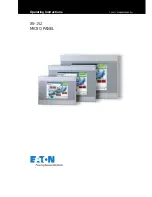
www.eao.com
45
Example data field for setting the brightness in Setting 2 for the top left LED of button 2 to 20%
(0x32):
CAN-ID
DLC Data
Byte 0
Data
Byte 1
Data
Byte 2
Data
Byte 3
Data
Byte 4
Data
Byte 5
Data
Byte 6
Data
Byte 7
0x18EFFF00 8
0x04
0x3D
0x0C
0x32
0x00
0x00
0x00
0x00
9.9.3.4 Choosing the temporal patterns for the Halo LED illumination
There are 5 predefined temporal patterns available for the halo LEDs.
Value
Setting name
Setting description
0x00
Steady
LED always on
0x01
Flash slow
LED flashing on and off with default value times
0x02
Flash fast
LED flashing on and off with default value times faster than 0x01
0x03
Pulsate
LEDs slowly turning off and on with default value times
0x04
Rotate
4 halo LEDs are slowly turning off one by one to visualize a
rotating ring
There are 2 ways to set the temporal pattern setting for the buttons.
1. Activation through Process data Prop A config message
This is described in 9.5.1. The corresponding message identifier is 0x14. The data bytes
1 through 6 are corresponding to buttons 1 through 6. This can be found in the K-Matrix
as well.
Example data field for setting the temporal pattern of all button halo LEDs to setting 1:
CAN-ID
DLC
Data
Byte 0
Data
Byte 1
Data
Byte 2
Data
Byte 3
Data
Byte 4
Data
Byte 5
Data
Byte 6
Data
Byte 7
0x18EFFF00 8
0x14
0x01
0x01
0x01
0x01
0x01
0x01
0x00
2. Activation through writing in the corresponding object with a write request
There is an object described in the K-Matrix that stores the information for the temporal
pattern setting for the halo LEDs. The object in question is number 106 (0x6A). The
subindex 0 through 5 correspond with the buttons 1 to 6. Writing an object is described in
chapter 9.4.3.
Example data field for setting the temporal pattern for button 2 to Setting 1:
CAN-ID
DLC Data
Byte 0
Data
Byte 1
Data
Byte 2
Data
Byte 3
Data
Byte 4
Data
Byte 5
Data
Byte 6
Data
Byte 7
0x18EFFF00 8
0x04
0x6A
0x01
0x01
0x00
0x00
0x00
0x00
















































